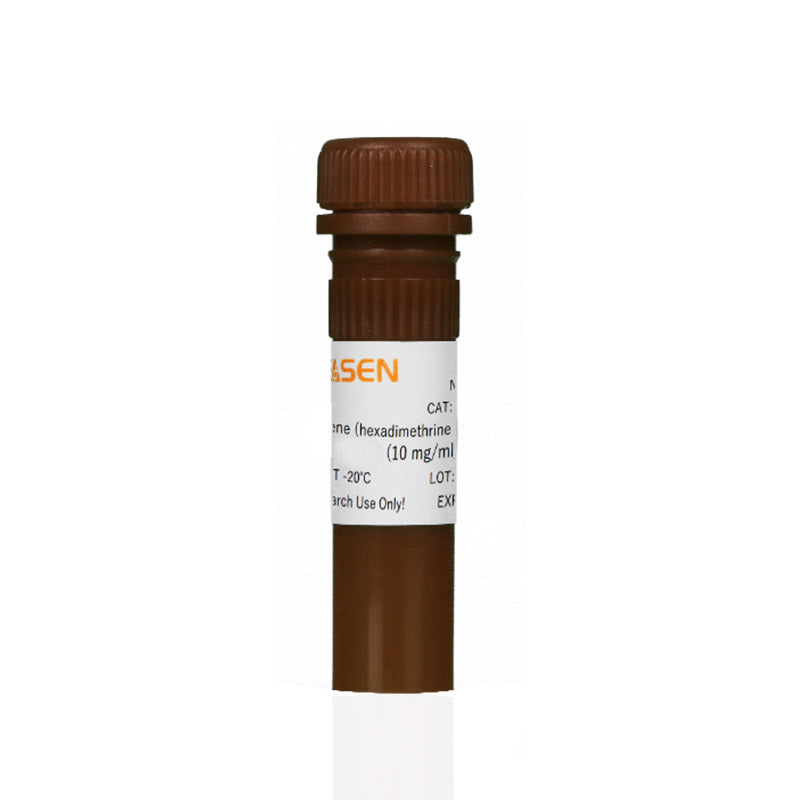Description
Specification
The product is provided in solution form, and the powder is reconstituted in 0.9% NaCl to make a 10 mg/mL solution, which is then sterilized using a 0.22 μm filter. It is typically diluted at a ratio of 1:1000-1:2000 for use, with specific dilution ratios depending on the cell type, as outlined in relevant literature.
Shipping and Storage
Transportation and storage are recommended at -20 ºC, with a shelf life of 2 years. It is advised to aliquot and store to avoid repeated freeze-thaw cycles.
Precautions:
-
Wear laboratory attire and disposable gloves for safety and health.
-
This product is for research purposes only.
Operational steps
(for reference, specific concentrations may vary, refer to relevant literature):
Note: Polybrene may exhibit significant toxicity to certain cells (such as terminally differentiated neurons, DC cells), and a toxicity test is recommended for initial use.
Experiment 1: Retroviral Infection
-
Preparation of recombinant retrovirus stock: Culture cells containing a monolayer of transfection retrovirus packaging cells in a 100 mm dish with 5 mL growth medium (5% serum). After 24 hours, remove the culture medium and filter it through a 0.45 μm filter.
-
Culturing cells for infection: In a 100 mm dish, add 10 mL complete growth medium with a cell density of 5×105 per dish.
-
Virus infection: After 24 hours of cell culture, remove the complete culture medium. Infect cells with 2 mL virus supernatant containing Polybrene (final concentration: 5-10 μg/mL) at 37°C for 3-6 hours.
-
Collect virus particles: Add 8 mL complete growth medium. After 2-3 days of culture, collect the culture medium to obtain virus particles.
Experiment 2: Transfection
-
Culture cells in complete growth medium with a cell density of approximately 50%.
-
After 18-24 hours of cell culture, prepare a DNA-growth medium-Polybrene mixture. Add complete growth medium (2 mL for a 60 mm dish, 3 mL for a 100 mm dish) and preheat to 37°C. Gently mix 10 ng~10 µg plasmid. Add Polybrene to a final concentration of 5-10 μg/mL. Gently mix. Each component should be added in the specified order.
-
Remove the culture medium and add the DNA-growth medium-Polybrene solution to the cells at 37°C for 6-20 hours. Gently mix every 1.5 hours within the first 6 hours of cell culture.
-
Remove the DNA-growth medium-Polybrene solution. Cover cells with DMSO shock solution (15% DMSO in 1× HBSS). Gently shake the culture dish for 10 seconds each time the solution is added to ensure even distribution. Incubate cells at 37°C for 4 minutes.
-
Immediately remove the DMSO shock solution and gently wash the cells twice with complete growth medium. For a 60 mm dish, wash with 5 mL of culture medium each time, and for a 100 mm dish, wash with 10 mL of culture medium each time.
-
Add complete growth medium to the cells.
-
Protein expression: After 24-72 hours of culture, collect cells for protein expression analysis as needed.
Cell selection: After 24-72 hours of culture, based on the cell status, switch to fresh selection medium and continue with cell selection.
Payment & Security
Your payment information is processed securely. We do not store credit card details nor have access to your credit card information.
Inquiry
You may also like
FAQ
The product is for research purposes only and is not intended for therapeutic or diagnostic use in humans or animals. Products and content are protected by patents, trademarks, and copyrights owned by Yeasen Biotechnology. Trademark symbols indicate the country of origin, not necessarily registration in all regions.
Certain applications may require additional third-party intellectual property rights.
Yeasen is dedicated to ethical science, believing our research should address critical questions while ensuring safety and ethical standards.

